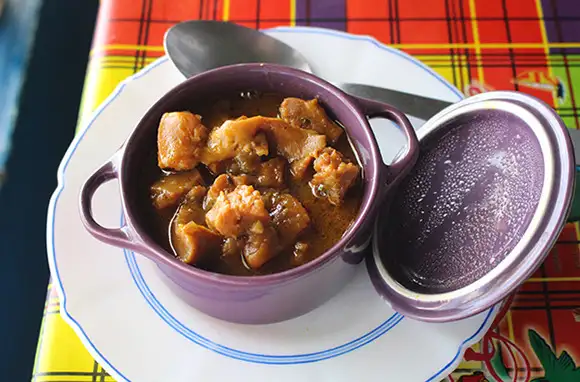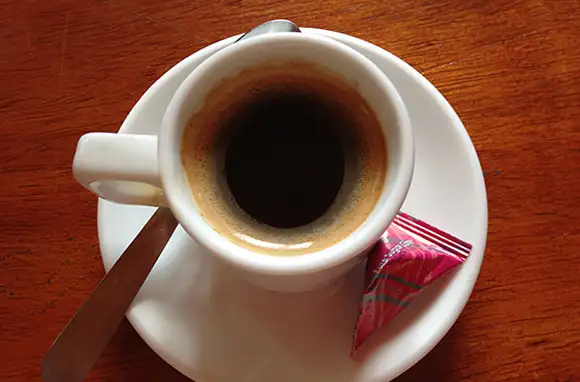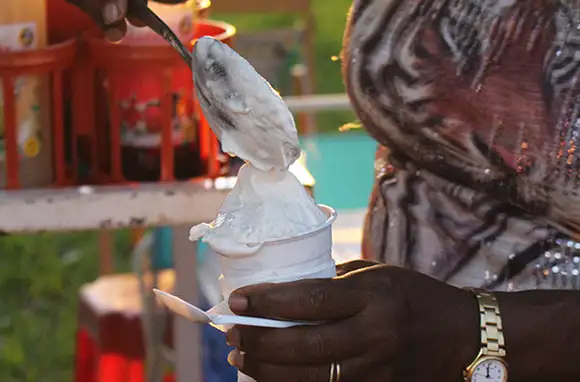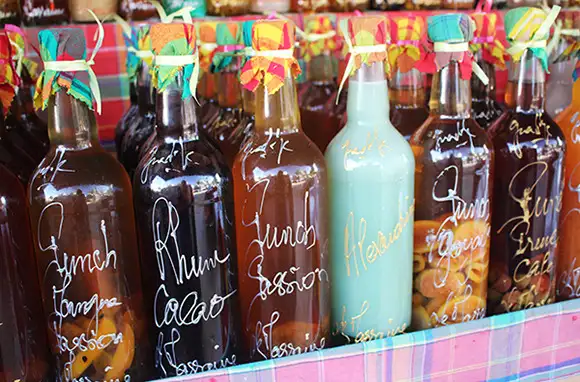As an overseas department of France, Guadeloupe is, unsurprisingly, a gastronomic paradise. But when you add in a fusion of Creole, African, and Indian culinary influences, the West Indian archipelago becomes unmistakably Caribbean.
No matter which island you visit—Grande-Terre, Basse-Terre, Marie-Galante, Îles des Saintes (Les Saintes), or La Désirade—you’ll discover a vast menu of flavors rooted in rich agricultural traditions from both the land and sea. And whether you indulge in exotic fruits and spices, cod fritters with an addictive “dog” sauce, or potent rum cocktails, you’ll surely be treated to a memorable tropical feast.
Image Gallery

Conch
The conch shell makes a mighty sound when blown, but it perhaps resonates most when calling you to dinner. Residing in its hard-sided, spiral-shaped home, conch (or lambi) often finds its way into Guadeloupian dishes such as queen conch fricassee, a hearty casserole cooked in a flavorful court-bouillon poaching liquid and served with a side of beans and rice. In its simplest preparation, the tropical marine mollusk is lightly seasoned and grilled.
Where to Find It: At the Top Local food truck in Sainte-Anne (Grande-Terre), lambi grillé is seared on a hot grill, doused with lime, and handed out in an easy-to-hold banana-leaf cone. Find traditional conch fricassee stewed in a personal-sized pot at Le Rivage, a French-Creole restaurant on a black-sand beach in Capesterre-Belle-Eau (Basse-Terre).

Conch
The conch shell makes a mighty sound when blown, but it perhaps resonates most when calling you to dinner. Residing in its hard-sided, spiral-shaped home, conch (or lambi) often finds its way into Guadeloupian dishes such as queen conch fricassee, a hearty casserole cooked in a flavorful court-bouillon poaching liquid and served with a side of beans and rice. In its simplest preparation, the tropical marine mollusk is lightly seasoned and grilled.
Where to Find It: At the Top Local food truck in Sainte-Anne (Grande-Terre), lambi grillé is seared on a hot grill, doused with lime, and handed out in an easy-to-hold banana-leaf cone. Find traditional conch fricassee stewed in a personal-sized pot at Le Rivage, a French-Creole restaurant on a black-sand beach in Capesterre-Belle-Eau (Basse-Terre).

Coffee
Made from 100 percent Arabica beans of the "Bourbon Pointu" variety, Guadeloupe's coffee is pure, sweet, low in acidity, and considered by connoisseurs to be some of the finest in the world. And because the coffee production is very small-scale—the beans are shade-grown under banana trees at habitations (plantations) high up in the rainforest—the resulting brews are quite a rare treat, too.
Where to Find It: On elevated terraces along the slopes of the Soufrière volcano, Le Domaine de l'Habitation la Grivelière in Vieux-Habitants (Basse-Terre) grows its 100 percent organic coffee beans—and cacao—like they did back in the day, and you can see the process firsthand on a guided tour. Be sure to sample a cup of espresso (no sugar necessary), and don't miss the creamy hot cocoa, steeped with milk, cinnamon, and a drop of bitter almond.

Tourment d'Amour
Who knew a pastry could cause such sweet sorrow? According to legend, an island woman fell madly in love with a sailor and baked a special treat to celebrate his return from the sea. When he didn't arrive at the expected time, she ended her life, leaving behind only a tart-like cake, which later became known as the tourment d'amour, or agony of love. Traditionally, fishermen's wives would entice their men to come home with these petite round pastries with irresistible, rum-soaked coconut centers (sometimes flavored with guava, pineapple, banana, and passion fruit). Who would be late for that?
Where to Find It: On the ferry docks of Les Saintes, island women sell the tourment d'amour from eye-catching, madras-lined baskets. Just don't ask them for the recipe, which they guard close to their hearts. The pastries are also available on dessert menus (with ice cream) at island restaurants.

Le Planteur
Rum might be Guadeloupe's "national" drink, but if the archipelago had a signature cocktail, it would likely be le planteur, a cheerful mix of tropical-fruit nectars (like guava, mango, and passion fruit) flavored with cane-sugar syrup, lime, vanilla, cinnamon, and a healthy dose of white rum. Just be careful: This punch packs a punch. Adorned with a sparkly sugar rim, it may seem innocent, but it becomes a true libation dangereuse when not consumed in moderation.
Where to Find It: Le planteur is the usual welcome cocktail at island resorts, and you can order one at nearly every restaurant and bar in Guadeloupe.

Cod Fritters and Dog Sauce
Want the perfect island snack? Then look no further than accras et sauce chien (cod fritters and dog sauce), the universal appetizer of Guadeloupe. Like savory beignets, these salt-cod fritters are deep-fried in a batter of flour, scallions, garlic, and spices and served at the beginning of nearly every meal. Made especially addictive when dipped into the islands' salivating go-to "dog" sauce—a vinegar-based condiment made not from dogs but from a zesty mix of carrots, onions, garlic, peppers, lime, and cumin—it's easy to fill up on them before the main course arrives.
Where to Find It: Accras et sauce chien are offered on restaurant menus throughout the islands, but you can learn how to make them yourself at Popots' Maison, a cooking school in Saint-François (Grande-Terre).

Sorbet Coco (Coconut Sorbet)
Little says classic beach fun like a scoop of homemade old-fashioned ice cream. And in Guadeloupe, locals call it sorbet and churn it right before your eyes in old-style, hand-crank machines—rock salt included. While it's possible to find tangy tropical-fruit sorbets on the islands, the focus here is coconut. Made with coconut and condensed milk—and flavored with sugar, cinnamon, nutmeg, lime, vanilla, and bitter almond—the frozen treat (called sorbet coco locally) has an airy texture and seems to capture all the sweetness of Guadeloupe in one satisfying cup.
Where to Find It: Look for casual mom-and-pop stands selling sorbet coco along Guadalupe's beaches, at markets, or in squares in front of churches and city halls.

Spices
If thick bundles of vanilla beans for €10 don't speak to you, the welcoming doudous in Guadeloupe's spice markets will. Dressed in madras-plaid dresses and headscarves as colorful as the buffet of spices before them, these sweet-talking women will lure you in with exotic scents and maybe offer a local recipe or two. Before long, you'll be filling your bag with packets of saffron, cinnamon, nutmeg, colombo (a type of curry powder), ginger, and West Indian bay. (Just make sure what you're buying is truly island-grown.)
Where to Find It: Have your choice of sellers as you weave through the bustling stalls at Marché Saint-Antoine, a large historical covered market in the heart of Pointe-à-Pitre (Grande-Terre). In Saint Anne (Grande-Terre), find a more laid-back, open-air market along the shore.

Cacao/Chocolate
Cross locally grown cacao with the techniques of a master European chocolatier, and you pretty much have Guadeloupian chocolate. Since the 17th century, island farmers have been cultivating cacao and transforming it into raw ingredients like pure cocoa butter and cocoa mass, a paste sold in markets in the form of "koko sticks" and traditionally used to make hot chocolate. But just like French chocolateries, island shops sell artisanal chocolate candies made with various cacao percentages and refined flavors like caramel au beurre salé (salted caramel).
Where to Find It: At Le Maison du Cacao in Pointe-Noire (Basse-Terre), stroll through the botanical garden to see the stages of chocolate production—from growing cacao to fermenting beans in banana leaves—then sample some hot cocoa or bonbons from the store. Fine chocolates are handcrafted by a Swiss chocolatier at Les Suprêmes in Vieux-Habitants (Basse-Terre).

Rhum
Whether brightened with a little lime and sugar or sipped like cognac, rum is the drink in Guadeloupe. And with the region's major sugar-cane industry and nine distilleries, it's no wonder. Throughout the archipelago, small family-owned companies produce mostly rhum agricole, which is made with pure cane juice instead of molasses (a byproduct of sugar production). And no matter which you prefer—white or dark aged rum—you'll be imbibing some of the Caribbean's best.
Where to Find It: Learn about the distillery process and taste rums (with varying degrees of aging) at Domaine de Bellevue on Marie-Galante. You can also pick up a bottle of fruit-infused rum at a local market, or simply kick back at a sleepy beachside cafe for a glass of ti-punch or le planteur, two favorite island drinks.
You Might Also Like:
We hand-pick everything we recommend and select items through testing and reviews. Some products are sent to us free of charge with no incentive to offer a favorable review. We offer our unbiased opinions and do not accept compensation to review products. All items are in stock and prices are accurate at the time of publication. If you buy something through our links, we may earn a commission.
Related
Top Fares From
Today's Top Travel Deals
Brought to you by ShermansTravel
Shop and Save with Country Inns...
Patricia Magaña
 Hotel & Lodging Deals
Hotel & Lodging Deals
$229 -- Chicago: Discounted Rates and...
Francesca Miele
 Hotel & Lodging Deals
$229+
Hotel & Lodging Deals
$229+
$188 -- Honolulu: Save on Oceanview...
Abigail Lamay
 Hotel & Lodging Deals
$188+
Hotel & Lodging Deals
$188+




